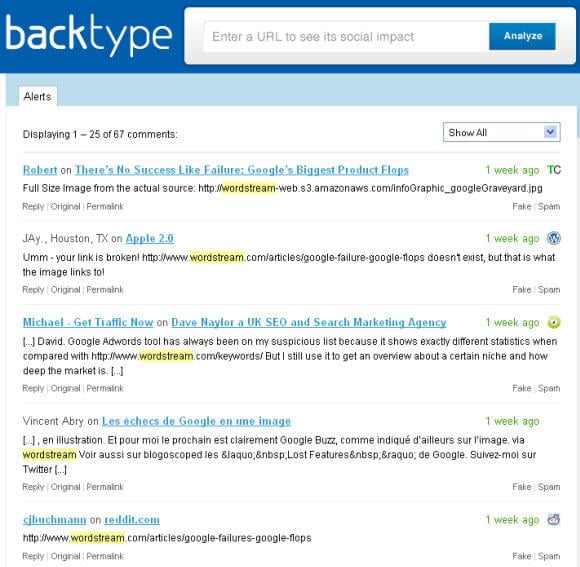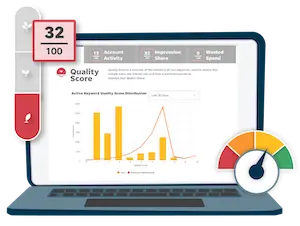
As any link wonk will tell you, link building is hard work. So for efficiency’s sake, I’m a big fan of harvesting the low hanging fruit in link building. Why kill yourself trying to acquire links from super domains, like CNN.com or The New York Times, when you can grab some quick wins just by tending your own garden?
One of the ways I snag some easy link wins is by turning citations into links. Of all the daily link building tactics I engage in, this is probably one of the best ROI producers. You see, at WordStream, we get cited dozens of times each day across the Web. Most of these mentions (I’d say about 70%) contain links back to our site. But roughly 30% are linkless. And therein lies the opportunity to build a link.
Now when it comes to local SEO, I know that citations are like links. In addition, it’s likely that search algos are using citations and endorsements as ranking signals. That’s all well and good. But for my money, I’d rather have a link because:
- A link is twice as a good as a citation (a link is both a citation/endorsement AND a conduit that sends traffic and link juice back to your site)
- Citations don’t send measurable traffic; links do
- Nobody gets paid for acquiring citations across the Web (correction…maybe PR brand evangelists do, but “citation building” is not part of my KPI bonus structure)
- Even if endorsements are used as a ranking signal (which I think they are), I doubt they carry as much weight in the algos as a link (today, at least IMO, but that could easily change with future algo updates)
Bottom line, if you’re not tracking brand mentions to build links, you’re squandering a golden opportunity. My success rate for turning citations into links is roughly 75%. How do I do it? Well, it’s not technically “magic” (as the title says), but the results are pretty darn magical. Anyway, read on and find out…
Step One: Find the Citations
In order to turn citations into links, first you gotta’ find the citations. Now, there are a number of listening tools on the market that allow you to monitor your brand mentions and sentiment. The ones I use every day are Google Alerts, Buzzstream and Backtype Alerts. Let’s take a quick look at what each does and how they differ.
Google Alerts: Google allows you to set up alerts for as many keywords as you like and track editorial citations across blogs, forums, news sites, video, social media, etc. Google Alerts is also a fantastic brand monitoring tool. I set up the alerts feature to ping me each time a brand mention occurs.
Doing this is simple. Here’s a quick screenshot.

Buzzstream: Now, Google Alerts is a great listening tool. But Buzzstream is better. Many search marketers may know of Buzzstream as one Hell of a link management tool (see my review on Buzzstream for link management). But Buzzstream also has a powerful set of brand and keyword monitoring tools as well, which let you take the pulse of virtually every conversation about your brand across the Web.
Backtype Alerts: The Backtype Alerts tool is unique in that it’s designed to track brand mentions (or keyword mentions) that occur only in the comments sections of blogs and comments. And like Google Alerts, when branded keywords are discovered in comments, you receive comment alerts via email.
Now, these listening tools really weren’t designed for link building. They’re fundamental value prop is serving as an online reputation management system, allowing companies to track conversations around the Web for their brand or target keywords. But, like I said, I use them primarily for link building and to alert me to link building opportunities that I may otherwise miss.
Step Two: Ask for a Link
Okay, so I’ve got these listening tools that notify me of brand mentions, now what? The next step is to visit the site and see whether or not the editorial citation is hyperlinked. As an aside, it would be great if one of the listening tools I’ve mentioned in the article (hint, hint: Buzzstream) would tell me whether or not the brand mention it has discovered contains a link. This would eliminate the effort of having to leave my brand monitoring dashboard and manually inspect each site, which would save me (and others) a lot of time. Anyway, just a thought…
So as I said, 70% of our mentions are linked (or contain a link somewhere on the page), but the other 30% of the time I visit a site that’s mentioned us only to find a sad little linkless editorial citation. The next step is to ask for a link. There are two ways to do this:
- Reach out to the site owner/article author (via email) to request a link
- Drop in a nice comment requesting a link
For your typical link building, content marketing or infographic outreach campaign, I strongly advocate conducting personalized outreach via email to ensure your link requests have the greatest chance of success. However, to turn citations into links, I’ve had fantastic results just by dropping a simple, courteous note into the comment section of the blog post or article. Which is great because when it comes to efficiency, commenting is far more economical.
Here’s an example of a typical comment/link request I’ve dropped into a post before, to give you an idea of what I’ve had success with.
| Hi, (blogger’s name).
Thanks for including our free keyword tool (or your brand, or your software product, whatever it is they’ve mentioned) in your list of the Top Free Tools for Search Marketers (whatever the topic of the post is). We really appreciate the exposure. By the way, it would be awesome if you could add a link to the tool, so that anyone in your audience who’d like to try it for themselves is able to access it directly, without having to search for it in Google. Thanks again, |
So the key points when fishing for a citation link with a blog comment are to:
- Use the author’s name: As I always stress, “personalize” all requests. Personalization also serves to distinguish you from spammers.
- Show your appreciation: Sure you haven’t gotten your link yet, but you did get a mention. So it’s worth being courteous and saying thanks.
- Note what the author said about your company: This helps jar the author’s memory and makes it easier for them to pinpoint in the post. For example, if they’ve mentioned you in a long list of 100 Web resources, referencing the citation is helpful.
- Mention the topic of the post: Shows you’ve actually taken the time to read the post, which, again, distinguishes you from spammers.
- Make it about helping the reader, not helping you: Phrase your request as an easier way for readers to access your site directly (which it is), and not as a way for you to build links and “dominate the SERPs,” which is obnoxious.
- Add your name and the name of your company in the comment: Again, it’s about personalization. Don’t hide behind an anonymous note. It doesn’t look professional. Also, view this as a networking and relationship building opportunity.
What NOT to do when asking for a link
WARNING: Do NOT Add a Link in Your Comment!!! Adding a link in the body of your comment or hyperlinking your name may undermine your efforts to snag a link. How, you ask? Well, simply put, it gives the author an out, a reason not to drop a link in the article. This is unfortunate because:
- Comment links are quite often tagged “nofollow”
- Comment links are likely devalued by the engines, via page segmentation
Case in point: I found an unlinked citation once, and asked for a link in the comments. Without thinking, I dropped in an active link to our site with my note, saying, “It would be great if you added a link to our site so people could find us: http://www.wordstream.com .” The blogger responded, “Looks like you’ve already added a link to your site yourself. Great!” Now, since my entire goal was to get a link in the body of the article, adding a link in the comments myself sabotaged my mission. Plus, the link was nofollow 🙁
Moral of the story, when asking for a link in this manner, don’t add a link. I know it goes against your very nature as a link builder, but try and show some restraint and let the author do it. Trust me on this one.
Why is This Method of Link Building so Darn Effective?
Good question. As I mentioned before, my success rate is very high (roughly 75% by my records) and far more effective than the typical cold link outreach or link marketing campaign. The reason the success rate is so high is that you’ve already earned a mention, so you’ve got one foot in the door. It’s very likely that the author has mentioned you in their article/post because they’re fans of your company, your product or you’ve done something noteworthy to warrant a mention in their eyes. So you’ve already earned a level of trust.
Now, obviously, this approach doesn’t work for affiliate scraper sites or article marketing or article spinning sites (we get mentioned a lot by the article spinners). So don’t even waste your time trying to get a scraper site to link to you. It’s not going to happen.
One final note that you may find interesting: many times when I’ve asked for links to unlinked citations, the blogger/author has been very appreciative because the omission of the link was not intentional. They tell me they simply just forgot or didn’t even think to add one. So there have been a number of times where I’ve even been thanked for the reminder, like I’m some sort of a link building Good Samaritan.
Who’da thunk, right?











Comments
Please read our Comment Policy before commenting.